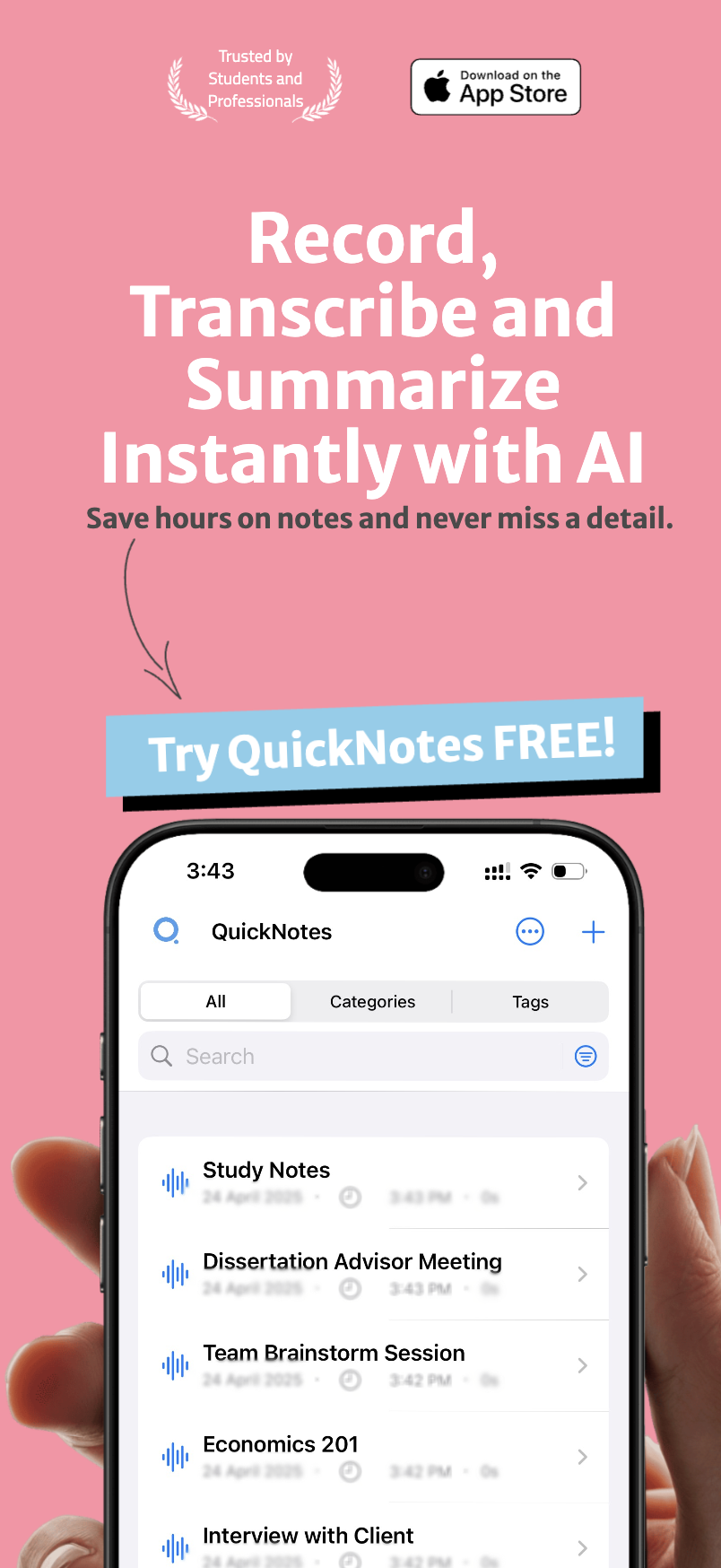Have you ever spent hours studying for an exam, only to find that you've forgotten most of it a few days later? Or attended a fascinating lecture where you understood everything perfectly, but couldn't recall the key points when you needed them? If so, you've experienced the Forgetting Curve firsthand—and you're not alone. This phenomenon affects everyone, but understanding it is the first step to overcoming it.
Table of Contents
- What is the Forgetting Curve?
- Why We Forget So Quickly
- 1. Cognitive Overload
- 2. Interference
- 3. Lack of Context and Connection
- Flattening the Curve: Strategies to Enhance Memory Retention
- 1. Strategic Review Timing
- 2. Active Recall
- 3. Create Meaningful Associations
- 4. Utilize Multiple Learning Modalities
- How QuickNotes Can Help Combat the Forgetting Curve
- 1. AI-Powered Summaries for Better Encoding
- 2. Searchable Transcriptions for Quick Review
- 3. Organization Tools to Create Meaningful Connections
- Practical Implementation: A Student's Guide
- Day 1: Initial Learning
- Day 2: First Reinforcement (24-hour mark)
- Day 8: Second Reinforcement (1-week mark)
- Day 22: Third Reinforcement (3-week mark)
- Exam Preparation
- Beyond Academic Learning: Professional Applications
- Conclusion: Working With Your Brain, Not Against It
- You Might Also Like
What is the Forgetting Curve?#
The Forgetting Curve, first described by German psychologist Hermann Ebbinghaus in 1885, illustrates how information is lost over time when there's no attempt to retain it. According to Ebbinghaus's research, if you learn something new and don't review it, you'll forget:
- Approximately 50% within the first hour
- Nearly 70% within 24 hours
- About 90% after a week
This steep decline in retention can be devastating for students and professionals who need to master and retain large amounts of information. The good news? Understanding this natural memory phenomenon allows us to develop strategies to combat it.
Why We Forget So Quickly#
Memory decay isn't a flaw; it's a feature of our brains. Several factors contribute to this natural memory decline:
1. Cognitive Overload#
Our brains process an estimated 74GB of information daily. To manage this flood of input, our minds must prioritize what's worth keeping and what can be discarded. Without signals that information is important (through review or application), our brains assume it's safe to forget.
2. Interference#
New information can interfere with previously learned material, making it harder to retrieve. This is why studying multiple similar subjects in one session can sometimes lead to confusion—the information gets tangled in your memory.
3. Lack of Context and Connection#
Information that doesn't connect to existing knowledge has fewer mental "hooks" to grab onto, making it more susceptible to forgetting. Our brains store information in networks, not isolated facts.
"The secret of a good memory is attention, and attention to a subject depends upon our interest in it. We rarely forget that which has made a deep impression on our minds." — Tryon Edwards
Flattening the Curve: Strategies to Enhance Memory Retention#
While the Forgetting Curve might seem discouraging, it actually provides a roadmap for more effective learning. Here are science-backed strategies to flatten the curve and retain more of what you learn:
1. Strategic Review Timing#
The most powerful way to combat forgetting is through strategically timed review sessions. Ebbinghaus found that each review strengthens memory and slows the forgetting rate. Optimal review intervals are:
- First review: Within 24 hours of initial learning
- Second review: After 1 week
- Third review: After 2 weeks
- Fourth review: After 1 month
2. Active Recall#
Passive rereading is far less effective than actively retrieving information from memory. Quizzing yourself, explaining concepts in your own words, or teaching material to someone else forces your brain to strengthen neural pathways.
3. Create Meaningful Associations#
Information with context and personal meaning is more resistant to forgetting. Connect new knowledge to existing understanding, use vivid examples, or create analogies that make abstract concepts concrete.
4. Utilize Multiple Learning Modalities#
Engaging multiple senses while learning creates redundant pathways to the information in your brain. For example, reading content aloud engages both visual and auditory processing, making the memory more robust.
How QuickNotes Can Help Combat the Forgetting Curve#
Modern technology offers powerful tools to implement these memory-enhancing strategies. QuickNotes is particularly effective at helping overcome the Forgetting Curve through several key features:
1. AI-Powered Summaries for Better Encoding#
QuickNotes can generate concise summaries of your recorded lectures, meetings, or study sessions. According to the QuickNotes Functions documentation, the app offers "AI-Powered Summaries" with "adjustable length" options (Short, Medium, and Long). These summaries help distill complex information into key points, making it easier for your brain to encode the most important concepts. When information is more clearly organized and prioritized, it's less susceptible to rapid forgetting.
2. Searchable Transcriptions for Quick Review#
The app's "Speech-to-Text" feature converts recordings to text with high accuracy. This creates searchable notes that allow you to quickly review specific concepts right when you're about to forget them. Instead of relistening to an entire lecture, you can instantly locate and review just the portions you need to reinforce.
3. Organization Tools to Create Meaningful Connections#
QuickNotes offers robust organization capabilities, including "Categories" and "Tags" to organize recordings and "Folders" to group related recordings. These tools help you create the meaningful associations that make information more resistant to forgetting by connecting related concepts together.
By combining these features with the strategic review intervals mentioned above, you can create a powerful system for flattening your personal Forgetting Curve.
Practical Implementation: A Student's Guide#
Let's see how these principles might work in a real-world scenario:
Day 1: Initial Learning#
Record your lecture or study session with QuickNotes. After class, use the app's transcription feature to convert the recording to text. Then generate an AI summary to identify key concepts. Review this summary once more before bed.
Day 2: First Reinforcement (24-hour mark)#
Spend 5-10 minutes reviewing your notes and summary. Focus on actively recalling information rather than just rereading. Test yourself on key concepts.
Day 8: Second Reinforcement (1-week mark)#
Use QuickNotes' search feature to quickly locate specific topics you're struggling with. Create connections between this material and new content you've learned since.
Day 22: Third Reinforcement (3-week mark)#
By this point, your review time can be brief—just enough to maintain the neural pathways. Focus on the most difficult concepts.
Exam Preparation#
When it's time to prepare for exams, you'll have well-organized, searchable notes with key concepts already highlighted. Rather than relearning everything from scratch, you'll mostly be refreshing knowledge that's already stored in long-term memory.
Beyond Academic Learning: Professional Applications#
The Forgetting Curve affects professionals as much as students. Whether you're learning new software, attending professional development training, or keeping track of client requirements, the same principles apply.
QuickNotes can be particularly valuable in professional contexts through features like:
- Multi-language Support: For professionals working in international environments, QuickNotes offers transcription in multiple languages with automatic language detection.
- Sharing Options: The ability to share transcriptions and summaries makes collaborative learning and knowledge transfer more effective.
- Exporting in Multiple Formats: This allows integration with other professional tools and workflows.
Conclusion: Working With Your Brain, Not Against It#
The Forgetting Curve isn't your enemy—it's simply how your brain works. By understanding this natural process and implementing strategic review, active recall, and meaningful connections, you can dramatically improve your long-term retention of important information.
Tools like QuickNotes make it easier than ever to implement these evidence-based approaches to learning. By recording, transcribing, summarizing, and organizing your learning materials, you create the perfect conditions for optimal memory retention.
The next time you learn something important, remember: it's not enough to understand it once. Plan your review strategy from the beginning, and watch as information that would have disappeared within days becomes part of your long-term knowledge base.
You Might Also Like#

AI-Powered Summarization: Extract Key Insights Instantly
Learn how QuickNotes' AI summarization technology helps you extract key insights from lengthy recordings and transcriptions, saving time and improving information retention.

Organization and Tagging: A System for Effective Information Management
Learn how QuickNotes' powerful organization and tagging system helps you categorize, find, and utilize your notes and recordings effectively.

Multi-Language Transcription: Breaking Down Communication Barriers
Discover how QuickNotes' multi-language transcription capabilities can break down communication barriers and streamline global collaboration.

